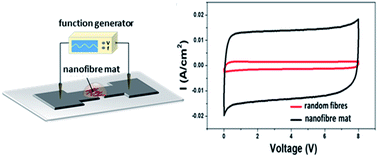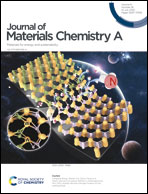Electric field assisted assembly of 1D supramolecular nanofibres for enhanced supercapacitive performance†
Abstract
One-dimensional (1D) nanomaterials, in the form of tubes, fibres or wires, tend to exhibit superior charge transport, a property borne out of their dimensionality. The challenge has been in controlling their random footprints during device fabrication, which is often addressed via dielectrophoresis. In the present work, we report dielectrophoresis aided guiding of 1D supramolecular nanofibres and assembling them to form a nanofibrous mat. The nanofibres are made up of a donor–acceptor assembly of coronene tetracarboxylate salt (CS) and dodecyl methyl viologen (DMV), containing K+ and Br− as counter ions, respectively, and they were drop-cast onto a Ti microgap electrode to perform as a solid electrolyte to construct a planar supercapacitor. To facilitate the alignment of nanofibres in the form of a mat across the electrodes, the applied electric field (both frequency and voltage) and the time duration were optimised. With an AC voltage of 2 V (peak to peak) at 500 Hz, the capacitance could be enhanced by up to an order. The device performed flawlessly up to a potential window as wide as 8 V, with semi-rectangular CV loops retained even with an ultrahigh scan rate of 10 000 V s−1. The device was found to be stable even after 50 000 charge–discharge cycles with 89% capacitance retention. Furthermore, by sprinkling hygroscopic KBr crystallites in the neighbourhood of the nanofibres while maintaining a relative humidity of 90%, the device performance was further enhanced by 20 times to achieve ∼388.3 mF cm−2, a remarkable value among planar supercapacitors.



 Please wait while we load your content...
Please wait while we load your content...